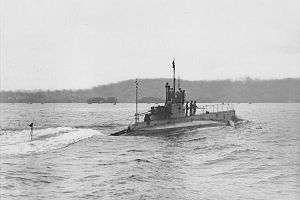Ha-3-class submarine
 Japanese submarine Ha-3, in August 1911 | |
| Class overview | |
|---|---|
| Builders: | Vickers, Barrow-in-Furness, UK |
| Operators: |
|
| Preceded by: | Ha-1 class submarine |
| Succeeded by: | Ha-7 class submarine |
| In commission: | 1911–1929 |
| Completed: | 3 |
| Retired: | 3 |
| General characteristics | |
| Type: | Submarine |
| Displacement: |
|
| Length: | 43.3 m (142 ft) |
| Beam: | 4.14 m (13.6 ft) |
| Draft: | 3.43 m (11.3 ft) |
| Installed power: |
|
| Propulsion: |
|
| Speed: |
|
| Range: |
|
| Test depth: | 30.5 metres (100 ft) |
| Complement: | 26 officers and enlisted |
| Armament: |
|
The Ha-3 class submarine (波三型潜水艦 Ha-san-gata sensuikan) was an early class of submarines of the Imperial Japanese Navy.
Background
Along with placing orders with Vickers at Barrow-in-Furness in the UK for two British C class submarines, which were commissioned into the Imperial Japanese Navy as the Ha-1 class, the Japanese government ordered another three vessels, which were received as knock-down kits. These kits were assembled at the Kure Naval Arsenal.[1]
Design
Physically almost identical to the Ha-1 class, the three vessels assembled in Japan incorporated a number of improvements, including extended bow for improved seaworthiness, improved rudder for surface handling, and an increase in the size of the bridge and conning tower.
Ships in class
- Japanese submarine Ha-3 (波号第三潜水艦 Ha-go Dai-san sensuikan), laid down 1 August 1910; launched 5 March 1911; commissioned 12 August 1911 as Submersible No.10; reclassified as 2nd class submersible on 4 August 1916, reclassified as 3rd class submarine on 1 April 1919; renamed Ha-3 on 15 June 1923, decommissioned on 1 December 1929. [2]
- Japanese submarine Ha-4 (波号第四潜水艦 Ha-go Dai-yon sensuikan), laid down 1 August 1910; launched 13 March 1911; commissioned 26 August 1911 as Submersible No.11; reclassified as 2nd class submersible on 4 August 1916, reclassified as 3rd class submarine on 1 April 1919; renamed Ha-4 on 15 June 1923; decommissioned on 1 December 1929. [2]
- Japanese submarine Ha-5 (波号第五潜水艦 Ha-go Dai-go sensuikan), laid down 1 August 1910; launched 27 March 1911; commissioned 3 August 1911 as Submersible No.12; reclassified as 2nd class submersible on 4 August 1916, reclassified as 3rd class submarine on 1 April 1919; renamed Ha-5 on 15 June 1923; decommissioned on 1 December 1929. [2]
References
- Chesneau, Roger (1985). Conway's All the World's Fighting Ships, 1906–1921. Naval Institute Press. ISBN 0-87021-907-3.
- Howarth, Stephen (1983). The Fighting Ships of the Rising Sun: The Drama of the Imperial Japanese Navy, 1895-1945. Atheneum. ISBN 0-689-11402-8.
- Jentsura, Hansgeorg (1976). Warships of the Imperial Japanese Navy, 1869-1945. Annapolis, MD: Naval Institute Press. ISBN 0-87021-893-X.
- Schencking, J. Charles (2005). Making Waves: Politics, Propaganda, And The Emergence Of The Imperial Japanese Navy, 1868-1922. Stanford University Press. ISBN 0-8047-4977-9.
External links
- Nishida, Hiroshi. "Materials of IJN". Imperial Japanese Navy.
Notes
This article is issued from Wikipedia - version of the 10/11/2015. The text is available under the Creative Commons Attribution/Share Alike but additional terms may apply for the media files.